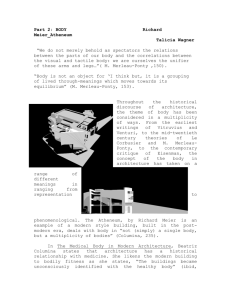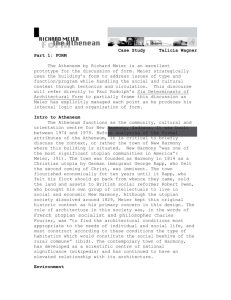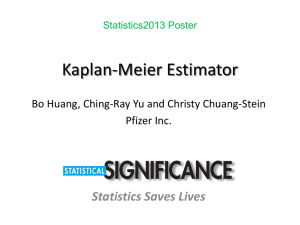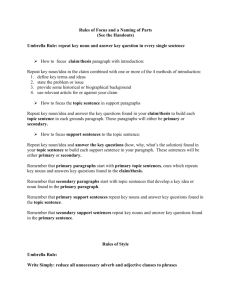PADM 7060 - Valdosta State University
advertisement
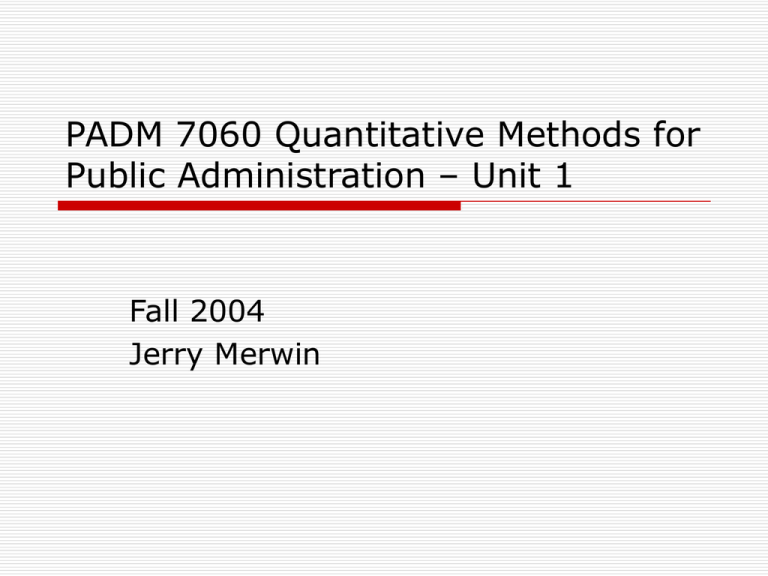
PADM 7060 Quantitative Methods for Public Administration – Unit 1 Fall 2004 Jerry Merwin Let’s review the syllabus: Syllabus (page 1) Description: The application of quantitative methods to problems faced by the public administration practitioners. Topics include regression analysis and the use of probability theory as they apply to decision making in public management. Texts: Meier, K. J., & Brudney, J. L. (2002). Applied statistics for public administration, (5th ed.). Fort Worth, TX.: Harcourt-Brace. Corbett, M., & LeRoy, M. K. (2001). Research Methods in political science (4th ed.). Belmont , CA: Wadsworth. Instructor: Gerald A. "Jerry" Merwin Jr., Ph.D. <gamerwin@valdosta.edu> Link to contact information. Office Schedule: The weeks of classes at Moody Air Force Base I will have office hours on Wednesday afternoons in West Hall. I will be available other times by appointment. If you need to schedule a meeting, please arrange an appointment time directly with me. Voice & Messaging: Cellular: 912.222.4693 VSU Office Telephone: 229.333.5771 FAX: 229.333.5910 More on Syllabus: Expected Outcomes ADA: http://www.valdosta.edu/ssp/ Course Requirements In addition to the textbooks, each student is required to have a calculator and graph paper. Class Policies Plagiarism: Read the information on the MPA web site: http://www.valdosta.edu/mpa/argyle/Plagiarism.pdf Sign the form: plag.form.only.sp04.doc Evaluation: Examinations 75% Homework & Participation 25% Total 100% Class Policies (Continued) Group Projects Communication Attendance Assignments Course Purpose Homework Examinations Project Submission Schedule General Overview Week 1 Tuesday, September 21, 2004 Introductions, Review of Syllabus, Policies, etc., Discuss Assignments Introduction to Statistics, Measurement & Research Design Meier & Brudney, Preface, Chapters 1 – 3, Problems 2.2 and 3.2 Corbett, Chapters 1 - 5 Conduct of Class Meeting/Arrival Time Breaks (Frequency & Duration) Ending Time (Amount of time spent in class) Interruptions/Disruptions/Side Discussions Consideration for Speaker Other issues Meier & Brudney: Preface What key point did you get from the Preface? Other related points: How many people have experience with measurement/statistics? Has anyone had an undergraduate course in statistics? Why is a statistics course in PA viewed differently from one in other master’s level programs? How are nonprofit examples important? Meier & Brudney Note list of symbols on page xxiii How are these important? What can you do to keep up with them? Meier & Brudney Part I: Foundations of Quantitative Analysis Chapter 1: Statistics and Public Administration Chapter 2: Measurement Chapter 3: Research Design Meier & Brudney: Chapter 1 Statistics and Public Administration What are the advantages of a statistical approach? Systematic description of data Precision & Quantification Tendencies & Spread of Data Empirical testing of hypotheses Making inferences about population from sample data Estimate error risk Examples? Meier & Brudney: Chapter 1 Statistics and Public Administration (Page 2) What are the advantages of a statistical approach? (Continued) Keep track of variables of great interest and concern (homelessness, poverty, illiteracy, crime, drug & alcohol dependency, child & spousal abuse) Make sense of relationships between variables Help public & nonprofit manager evaluate data from reports, evaluations, memoranda, journals, etc. Meier & Brudney: Chapter 1 Statistics and Public Administration (Page 3) How can it help managers to study statistics? Reduce “seat-of-the-pants” decision making. Improve projections on staffing and other needs. Allow higher quality evaluation of programs. Produce better design of systems (transportation, etc.) Improve range/continuum of options regarding data review and reports: From not reading them To taking the data and/or interpretation at face value, Read and understand data and interpretations. So middle option makes more sense! Meier & Brudney: Chapter 1 Statistics and Public Administration (Page 4) What is the role of calculation? We get a better understanding of statistics from the computation. Calculations tell us what we get from what we enter. Why not use statistics software for PC? Meier & Brudney: Chapter 1 Statistics and Public Administration (Page 5) How are NASPAA Standards involved? National Association of Schools of Public Affairs and Administration provides accreditation for graduate programs. “NASPAA Stipulates that the ‘common curriculum components shall enhance the student’s values, knowledge, and skills to act ethically and effectively in the application of quantitative and qualitative techniques of analysis (Meier & Brudney, p. 7).’” Meier & Brudney book intended to satisfy NASPAA requirements. Meier & Brudney: Chapter 1 Statistics and Public Administration (Page 6) What is the purpose of the “Road Map” for the book at the end of Chapter 1? Meier & Brudney: Chapter 2 Measurement What is measurement? (See page 13) Explain “Measurement Theory” and how “concepts” are involved. What is an “Operational Definition” and how is it important? How is an “Indicator” important? Let’s look at some examples (on page 14…) Explain “Multiple Indicators” and triangulation. Meier & Brudney: Chapter 2 Measurement (Page 2) What are “Measurement Validity” and “valid indicator” as explained in our book? Convergent Validity Discriminant Validity How can validity be established? Face validity? Consensual validity? Correlational validity? Predictive validity? Meier & Brudney: Chapter 2 Measurement (Page 3) Explain “Measurement Reliability” or “Reliability Indicator” What are the two major threats measurement reliability? (page 17) Subjective Measure Lack of Precision How do we measure reliability? Test-retest Parallel forms Split-half Meier & Brudney: Chapter 2 Measurement (Page 4) What types of measures are used? Subjective Objective Unobtrusive Explain reactivity or reactive measure Meier & Brudney: Chapter 2 Measurement (Page 5) What are levels of measurement important? Interval Ordinal Nominal Summary of chapter Meier & Brudney: Chapter 2 Measurement Problem 2.2 Compile a list of indicators that could be used to evaluate the quality of a city’s sanitary landfill (garbage dump). Meier & Brudney: Chapter 2 Measurement Any questions? Meier & Brudney: Chapter 3 Research Design (Page 1) Let’s discuss the example at the beginning of the chapter, the “Stand Up for Bison” program. Senior citizens below the poverty line were supposed to have improved quality of life by moving to new federally subsidized public housing (Meier & Brudney, p. 25). Turns out the program does not work, so it is terminated, with a loss of federal funds and jobs (Meier & Brudney). A local newspaper blames the mayor and his “cronies” and suggests that skimming of funds might have been involved (Meier & Brudney). Meier & Brudney: Chapter 3 Research Design (Page 2) How does Dick Murray, strategist for the mayor, help save the day for the mayor and his staff? Murray does research and finds a similar city (Virtuous, Montana) has a successful program. Comparing the two programs, Murray finds the following factors: Interest of Mayor Lewis and staff is comparable to those in Virtuous. Competence of mayor and staff is similar. Federal funding was lower for Bison! Meier & Brudney: Chapter 3 Research Design (Page 3) How does the example relate to our chapter 3 topic? Social science research is often focused on a search for causal relationships between variable and events. Murray was using research to help resolve the major political concern of the “failed program” and identify some other possible factors to find the cause of the failure. Meier & Brudney: Chapter 3 Research Design (Page 4) How do we construct causal explanations? (Page 27) See some examples of questions related to factors involved in the social programs and their success or failure. Explain how the “Concept” is involved. What does the author mean by saying that “concepts act as a perceptual screen” (Meier & Brudney, p. 27)… Meier & Brudney: Chapter 3 Research Design (Page 5) What is “Empirical Research” and how is it important? What are the two types of definitions related to empirical research? Nominal or Conceptual Definitions Operational Definitions (see page 28) How does a concept become a variable? (see page 29) Meier & Brudney: Chapter 3 Research Design (Page 6) What are the two main types of variables? Dependent Independent What is a hypothesis and how is it important? What is a theory? What are assumptions? Meier & Brudney: Chapter 3 Research Design (Page 7) What is a model? See an example on page 31. Explain multiple causation. How is it important in social science research? What are the relationships of the following terms: covariation, partially spurious, etc., see page 34. How can an arrow diagram help sort out variables and interrelationships in multiple causation? Meier & Brudney: Chapter 3 Research Design (Page 8) What is research design? When talking about causality, we are concerned with: Internal validity External validity Make a distinction between: Experimental research designs Quasi-experimental designs Meier & Brudney: Chapter 3 Research Design (Page 9) Experimental Research Designs (37) Internal validity Steps 1 through 5 See Table 3.2 for classical design Explain the importance of random assignment. Outline the criteria for causality. (38-39) External validity issues with experimental designs: Context Pretesting Solomon four-group design See Tables 3.3 & 3.4 Sample: Captive Populations Meier & Brudney: Chapter 3 Research Design (Page 10) Quasi-Experimental Designs (41) Internal validity (See table 3.5) Cross-sectional study (a.k.a. correlational study) Case study Panel study Trend studies Longitudinal studies Major threat? (See pages 43-44 for cause/solution) External Validity Easy to get good samples Typically occur in “natural” environment Meier & Brudney: Chapter 3 Research Design (Page 11) Research Designs & Validity Trade-off between internal and external validity General difficulty of obtaining reliable causal inferences Examples: research on job attitudes and performance – “Where are we now?” Also, typical conjecture on causal relationships without meeting criteria Summary Meier & Brudney: Chapter 3 Research Design (Page 12) Problem 3.2: Develop a model that includes at least four concepts. Elaborate any theoretical or literature support underlying it. Present the model in an arrow diagram that shows schematically the relationships the model proposes. Provide operational definitions for all the concepts, and state hypotheses derived from the model. Which types of research design would be best suited to testing the model? Which types of research design would bes least suited to testing the model? Meier & Brudney: Chapter 3 Research Design (Page 13) Questions?

